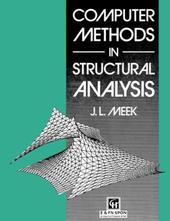
|
Computer Methods in Structural Analysis
Paperback / softback
Main Details
| Title |
Computer Methods in Structural Analysis
|
| Authors and Contributors |
By (author) J.L. Meek
|
| Physical Properties |
| Format:Paperback / softback | | Pages:524 | | Dimensions(mm): Height 248,Width 191 |
|
| Category/Genre | Structural engineering
Computer science |
|---|
| ISBN/Barcode |
9780419154402
|
| Classifications | Dewey:624.1710285 |
|---|
| Audience | | Undergraduate | | Postgraduate, Research & Scholarly | | Professional & Vocational | |
|---|
|
Publishing Details |
| Publisher |
Taylor & Francis Ltd
|
| Imprint |
Spon Press
|
| Publication Date |
8 August 1991 |
| Publication Country |
United Kingdom
|
Description
This book uses fundamental theorems of structural mechanics to explain the connection between statics of structures and their deflections on the one hand, and the kinematics of structures and their equilibrium on the other. It develops the theory and techniques of finite element and non-linear analysis applicabale to computer software. Computer Methods in Structural Analysis brings a unified approach to the analysis of conventional truss and frame structures and the finite element approximation of the continuum via the priciples of virtual displacements and virtual forces. These principles can be succintly expressed in the form known as the contragredient law. Concepts of elasticity and elasto-plastic constitutive laws are discussed and a broad introduction given to the various approaches used in the finite element method. A treatment is then given for line element structures using both the force and the displacement method, and in the latter case, the theory is extended for non-linear large displacement analysis. Practical means are presented for the calculation of critical loads on such structures. Three chapters are devoted to the finite element method in which continuum thoery, torsion, heat transfer, plates and shells are discussed in some detail. In this finite element theory, both conventional methods (via contragredience) and the natural mode technique of Processor J H Argyris are explained. Topics such as the calculation of the shear centre via the finite element method are also included. Various plate elements are discussed in detail and studies of their performance, and the new DKL facet element are presented. Tension net and tension fabric structures and thier shape determination and analysis are comprehensively discussed. Details are given for eliminating the shear and membrane locking experienced in the simple formulation of the isoparametric degenerate shell element.
|